The Best Livestock Guardian Dog for Chickens

Plan your best garden with simple, step-by-step instructions!
This post may contain affiliate links, which means I make a small commission at no extra cost to you.
See my full disclosure here.
Note from Kathleen: Today I’m welcoming my favorite guest post author…my husband, Mr. Native Texan! Also known as Greg. He’s definitely the animal expert on our homestead, so I’m going to let him tell you all about our experience with our livestock guardian dog Mudge.
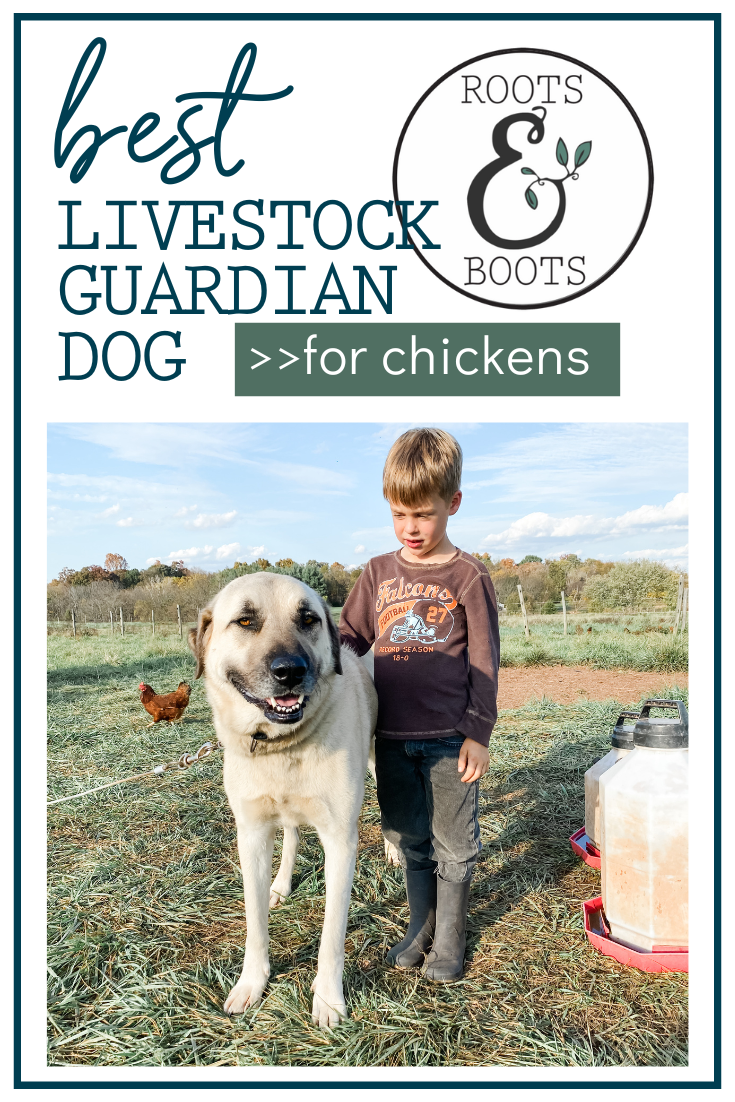
Here at the Roots & Boots Homestead we love to raise chickens for eggs and for meat. The quality of our homegrown eggs and chickens doesn’t even compare to the stuff available at the grocery store Here’s why.
However, raising poultry does pose a few problems. One of our biggest challenges to date has been keeping the birds alive.
The meat birds are fairly easy to protect because they’re contained in a mobile pasture coop (a chicken tractor). The challenge comes with the laying hens. We’ve dealt with foxes, raccoons (we found one sleeping in the chicken coop!!), hawks, snakes, and worst of all, our own dog!
When we first moved to our 3-acre starter homestead we had a beautiful Weimaraner named Trooper. Trooper was great with kids and was a wonderful pet, but there was a big problem—he was a bird dog.
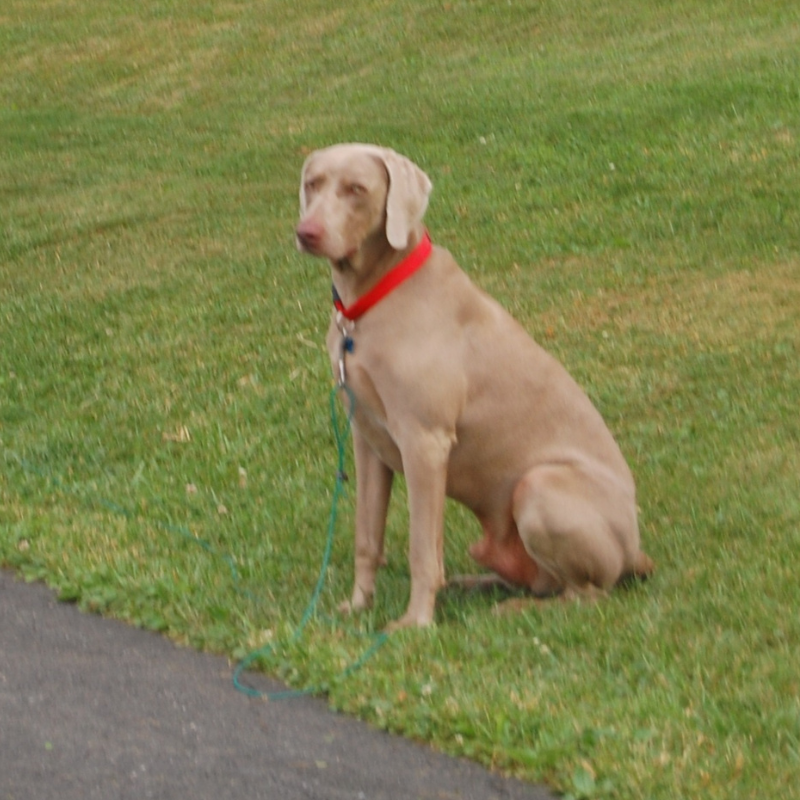
Trooper the Weimaraner was bred to hunt birds and he was good at it. Back in Texas I would take him jogging in our neighborhood. More than once that dog caught a dove right out of the air in the middle of a run! So it shouldn’t have surprised us that he would do the same with chickens.
When we first introduced chickens to our homestead, it didn’t appear to be a problem. Trooper would stay by my side while I fed them. The birds even walked up to and around him and he didn’t bother them.
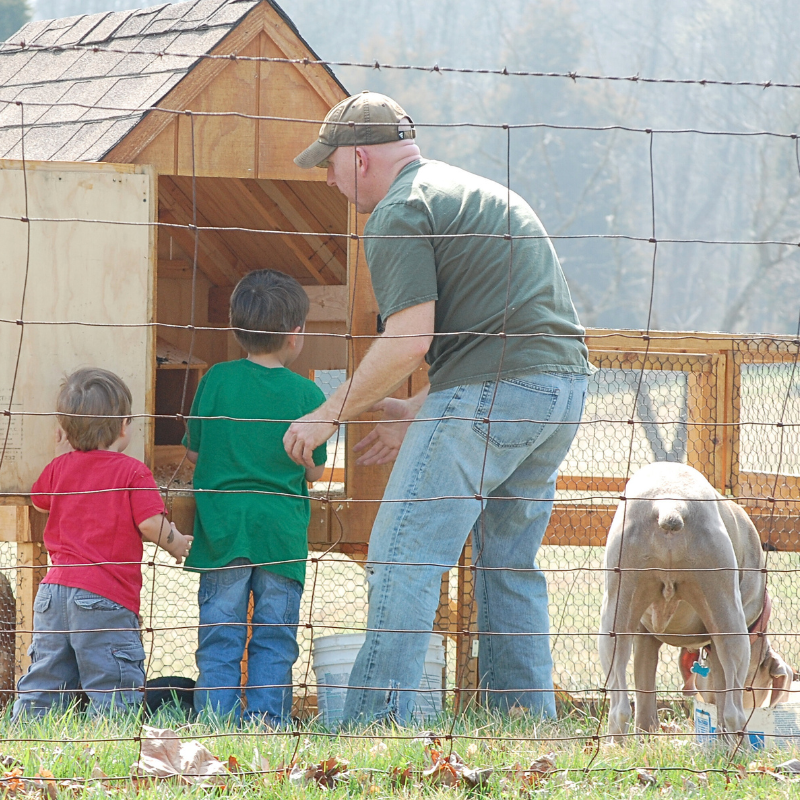
Leaving him unsupervised with the chickens was another story altogether. I can remember working on our front porch one day and all of a sudden, Trooper appeared with a chicken in his mouth. He dropped it at my feet and stood waiting for my praise.
Obviously, we decided to separate Trooper from the chickens. We were able to fence the chickens in and still give them plenty of room to free range. Problem solved, right? Well, not exactly.
It did solve the dog issue, but introduced a new predator problem: hawks. You can always tell when a hawk has paid a visit to your homestead. A missing chicken and a big pile of feathers is a sure sign!
After conferring with Kathleen’s cousin, who accomplishes more on 3/4 acre than many folks do with 20, we learned that a hawk won’t fly into a narrow space. Armed with this new information, we built a chicken run.
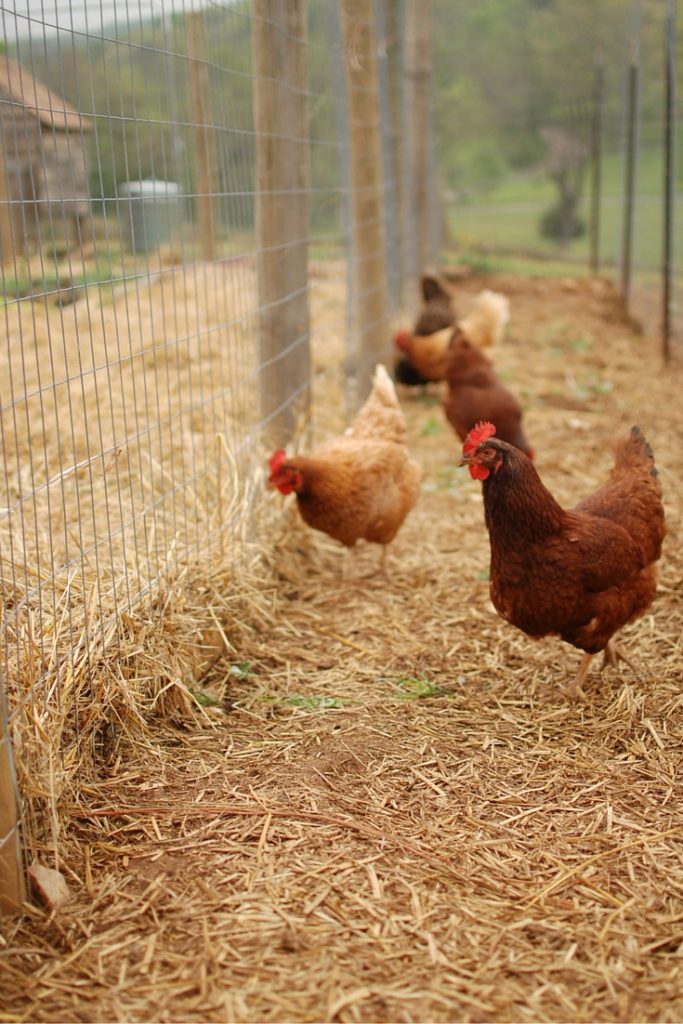
The chicken run solved several issues, but it still didn’t allow the chickens to free range. We gave them a little more space by allowing them to access our garden area. We stretched fishing line across the top of the garden space to deter hawks and placed chicken wire around the raised beds to protect the vegetables. However, this still didn’t allow for free ranging, and we still had the occasional raccoon.
When good ‘ole Trooper passed away in the summer of 2015, we started pondering dog breeds. This time around we wanted a dog that would be good with kids, not eat chickens, and serve as a guardian to any additional livestock we acquired on the homestead. We needed a livestock guardian dog.
Our research led us to the Anatolian Shepherd. It took a while to find an affordable breeder on the east coast, but our big dog Mudge finally joined our homestead on Christmas Day 2017.
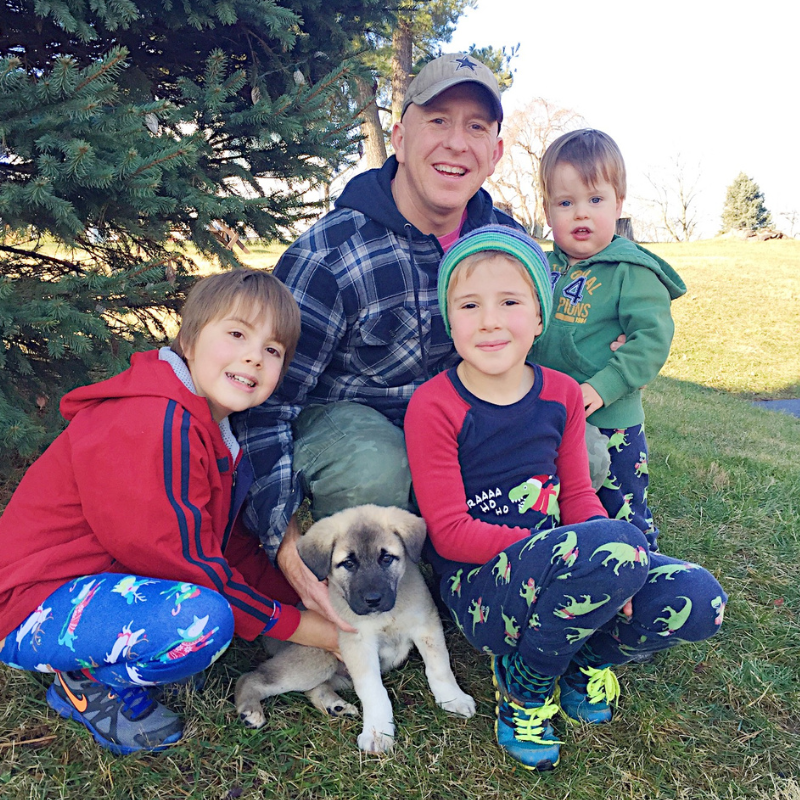
Anatolian shepherds were bred in the Anatolian region of what is now Turkey. They were raised to protect goats and chickens from natural predators found in those areas. That mountainous region has very hot summers and very cold winters. This livestock guardian dog was bred to handle both extremes.
Anatolians are also very good natured. They are sedentary and don’t require large amounts of food for such a large breed. Another plus is the Anatolian’s low maintenance short coat.
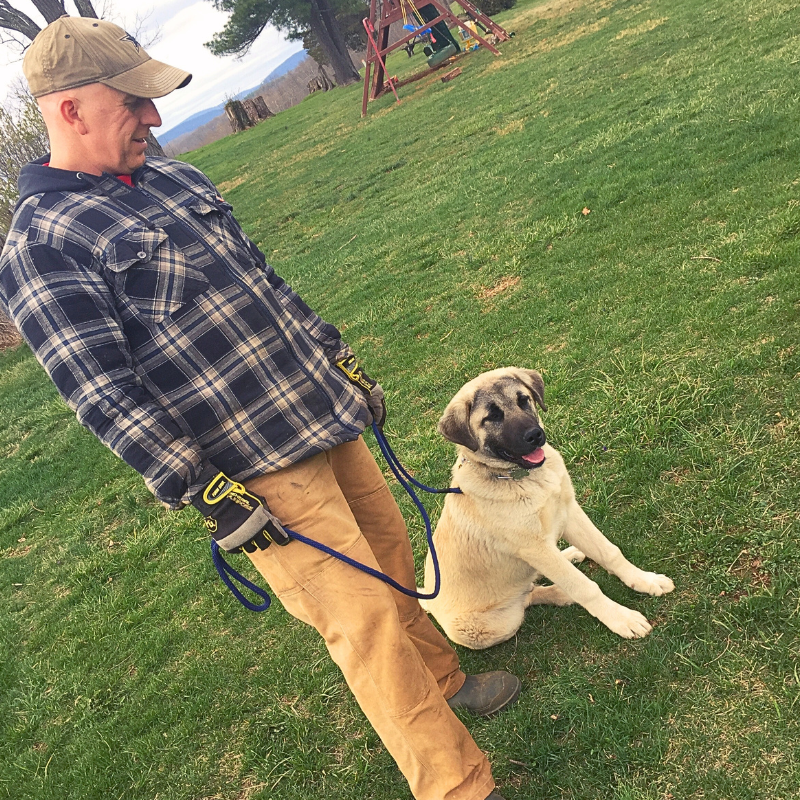
Despite these advantages, we soon discovered there might be more to raising a livestock guardian dog than we’d expected. Everything I’d read mentioned that these dogs were for experienced dog owners only. “That’s me”, I thought. “I’ve had dogs my entire life. I’m an experienced dog owner.”
Well, not so fast. When I first picked up Mudge from his breeder, this 3-month old puppy refused to be placed in a crate in our car. I caved to his desire and held him in my lap all the way home. That was probably my first mistake.
To this day, Mudge refuses to enter a crate, car, or confined area other than his pen. This makes it impossible to transport him anywhere, like the vet. It’s hard to argue with a 130-pound mass of muscles, teeth, and claws, so we’re thankful for our country vet who makes home visits. We’re still not sure how we’ll get him to the new homestead when we move…UPDATE: We used a horse trailer!!
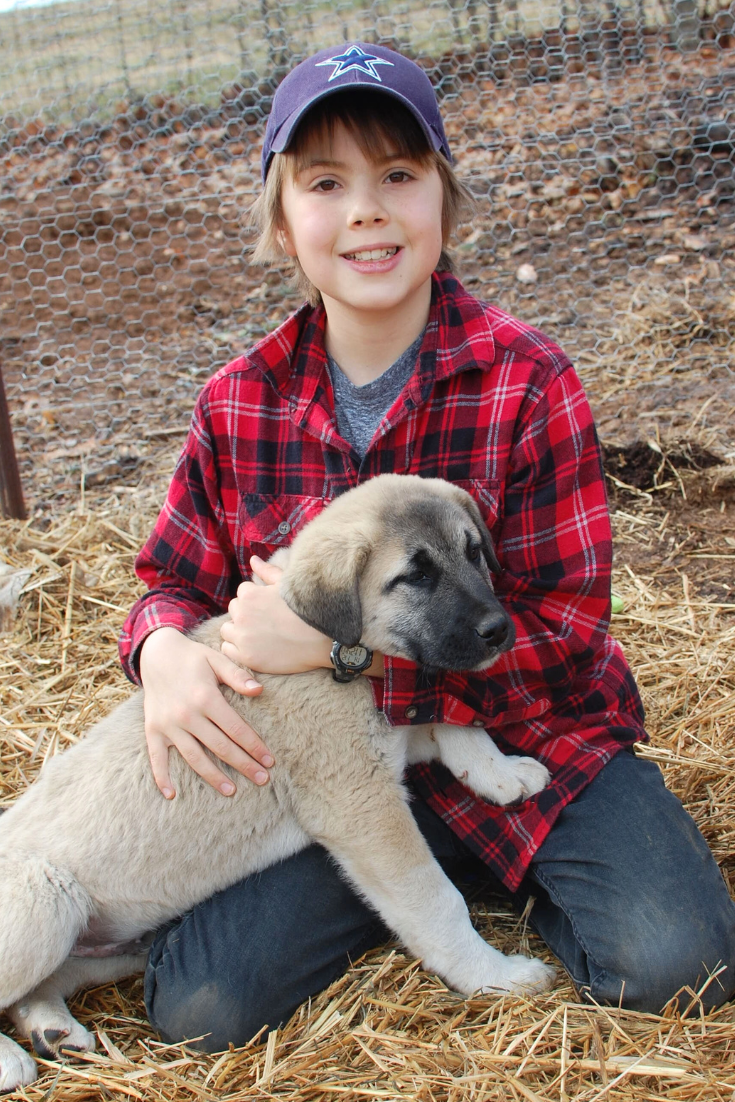
Over the next several months Mudge proceeded to ruin several of the boys’ jackets with his razor sharp puppy teeth. He also destroyed some of my own outerwear, shirts, and gloves. He was growing too fast to keep up with.
I tried every training technique learned from previous experiences with dogs, but none of it seemed to work. Mudge wasn’t necessarily bad, he was just being a puppy. A huge puppy with sharp teeth and claws. Everyone was afraid of our new livestock guardian dog. Our youngest son refused to go outside for two months.
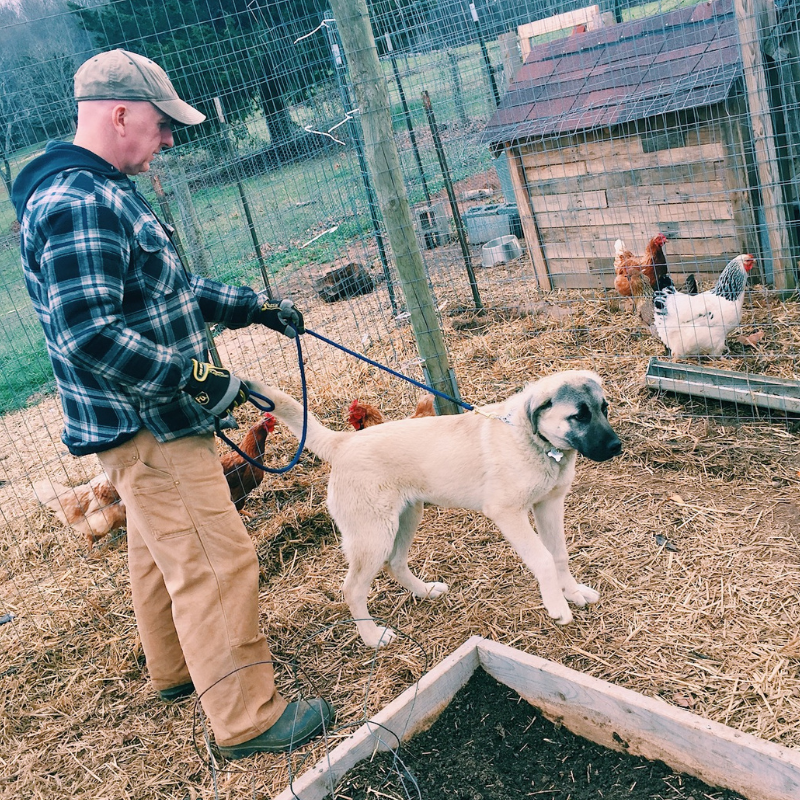
It was also impossible to keep Mudge contained. I built a small pen for him next to our chicken run. I’d read that he should bond with the chickens as a puppy in order to learn his job, and that he shouldn’t have unsupervised time with them until he was fully trained.
Well, he busted right out of this wire pen. Furthermore, he would then climb over the fence that surrounds our garden area and chicken coops, barbed-wire and all! Nothing seemed to faze this dog.
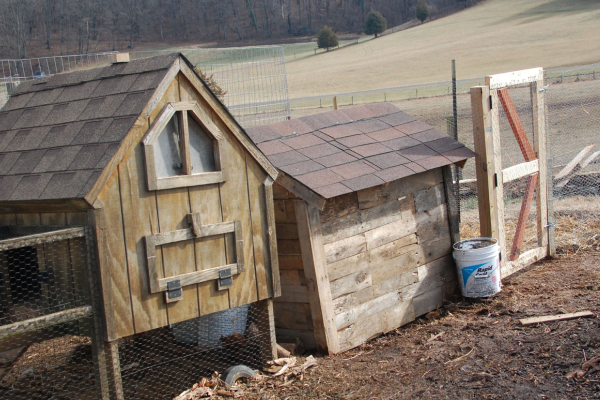
We finally called in the professionals, a local dog trainer who had been trained by Cesar Millan. After 30 minutes with Mudge, this trainer agreed that we had a challenge on our hands.
She provided helpful tips like reducing the size of his pen—similar to crate training; teaching him a go-to-place command to make sure he would go back into his pen; and working with him on a leash with a pronged collar. I also learned that I should sit on him when he was getting out of hand to show dominance. All of this helped, but it didn’t completely solve our issues.
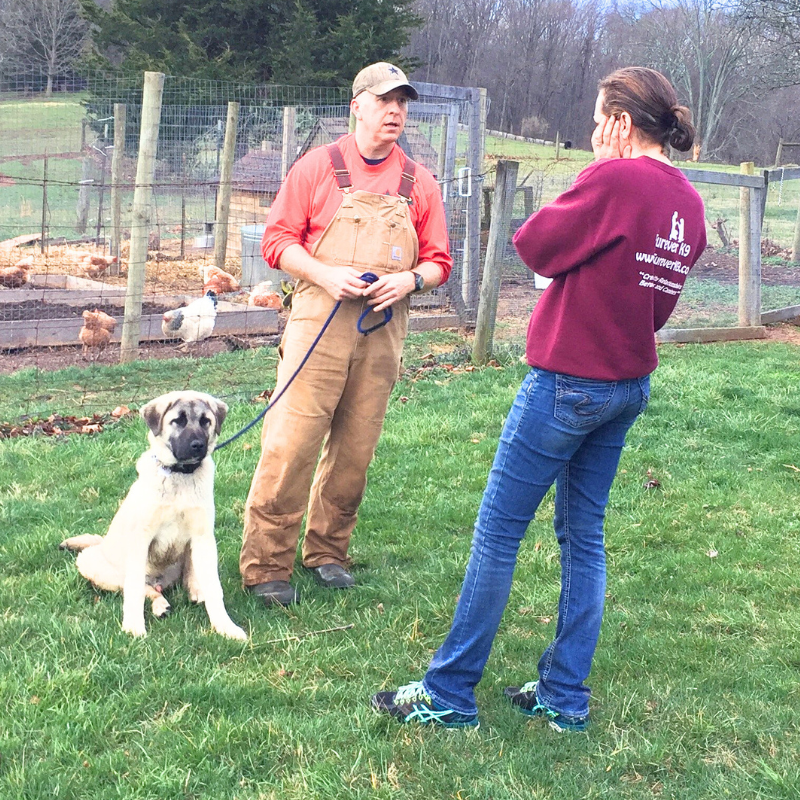
Then one night we were having dinner with some friends who had an extremely well behaved Labrador. I wanted to know their trick! It turned out our friend had a very difficult time with his dog until he purchased a shock collar. He said after brief training with the collar, the dog’s demeanor improved greatly.
Our friend generously loaned me the collar. I kid you not, after two days with that collar, Mudge became a different dog. I don’t want you to think we were cruel, because we weren’t. I had to use the shock button only a few times before he figured it out. Another button on the remote makes a beeping sound without a shock. Very soon, this beeping sound alone almost always secured Mudge’s obedience.
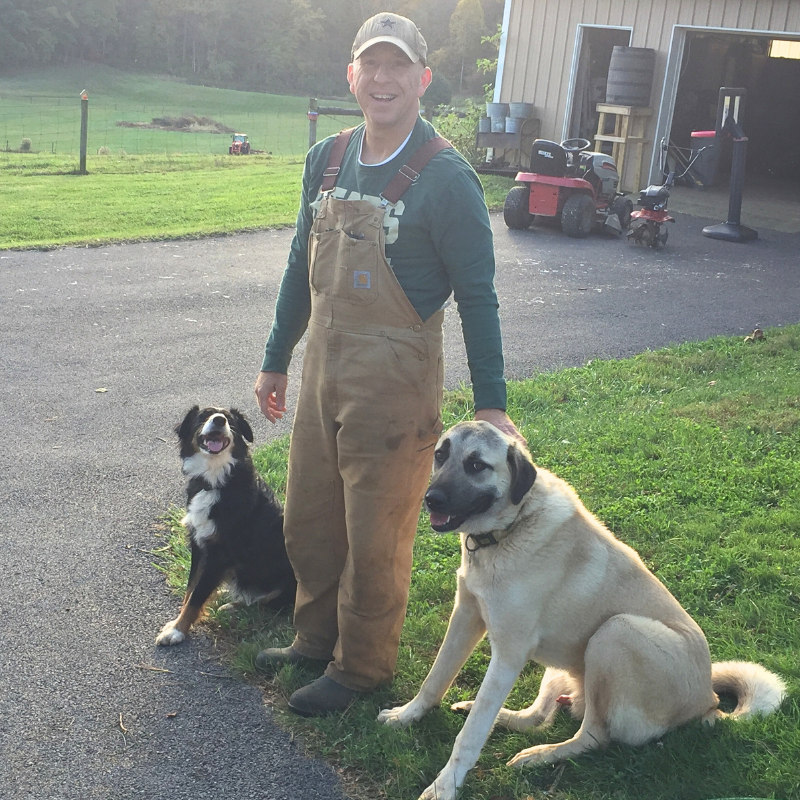
The only remaining problem is the escape routine. We plan to fix that with an electric fence. Once the fence is in place, the chickens should be able to free range again, with Mudge the livestock guardian dog as their protector.
Update: after we moved to our 20-acre farm and assigned Mudge a clear job of guarding chickens and livestock in a large, multi-acre field, the escape issues disappeared.
He’s already an excellent guardian: we’ve had zero chicken casualties since Mudge arrived. In fact, if the chickens happen to get out of their run, they tend to hang out with Mudge in his pen. They know what’s good for them!
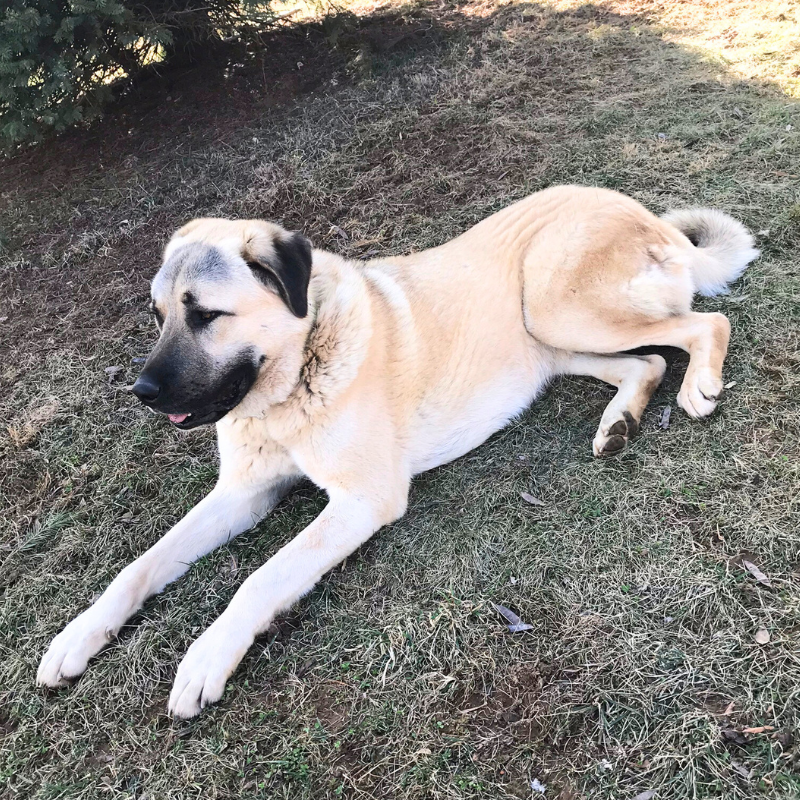
10 things to know about Livestock Guardian dogs (especially Anatolian Shepherds)
1. They are only for experienced owners who are willing to invest the time it takes to train them. It will require time and effort, but in the end you’ll be rewarded with an excellent livestock guardian dog.
2. They need a job. If you don’t give them something to do, they will find something to do. Believe me, it probably won’t be something you want them to do.
3. They bark at night. A lot. If you live close to neighbors who are not dog lovers, you may want to reconsider.
4. They need space or a secure enclosure. Give your livestock guardian dog a wide area to explore or a very secure fence, or both. Be ready: this dog will find a way to escape. Some farmers even attach a club to the dog’s collar to keep him from going over or through fences.
5. They can be dangerous. This is a working dog, a guard dog. Train every member of your family to respect the dog’s nature, especially when it comes to their food or their guarded livestock. When Mudge has a bone, he terrifies even me. I’ve taken to giving him bones only in his pen and never around others dogs or children.
6. They will probably require brief use of a shock collar. In my opinion, it’s a must-have until the dog is fully trained.
7. They should be close to but separated from livestock until fully trained. Make sure to keep the dog penned next to your flock or herd until he has bonded with them and understands his boundaries. He may not intentionally injure a chicken or goat, but his enormous size makes it a possibility.
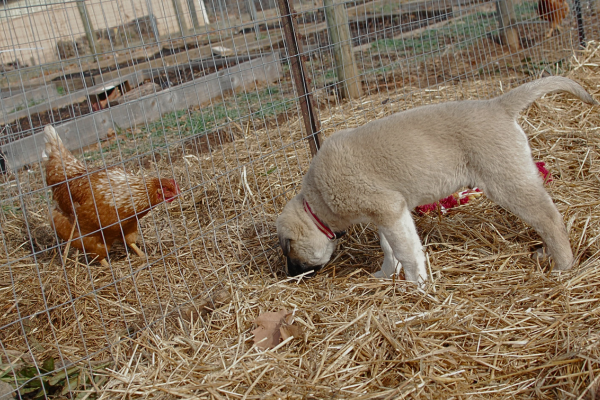
8. They need to socialize with all members of the family, including pets. Remember, this dog’s purpose is to protect your flock. He will perceive your pet as a threat unless you teach them to be friends.
9. They adapt easily to extreme temperatures. Mudge even seems to enjoy frigid winter weather! This dog is second only to the Husky in cold hardiness.
10. They will be an amazing addition to your homestead. Mudge is sweet and loving, easy going, and takes his job seriously. He protects both livestock and owners.
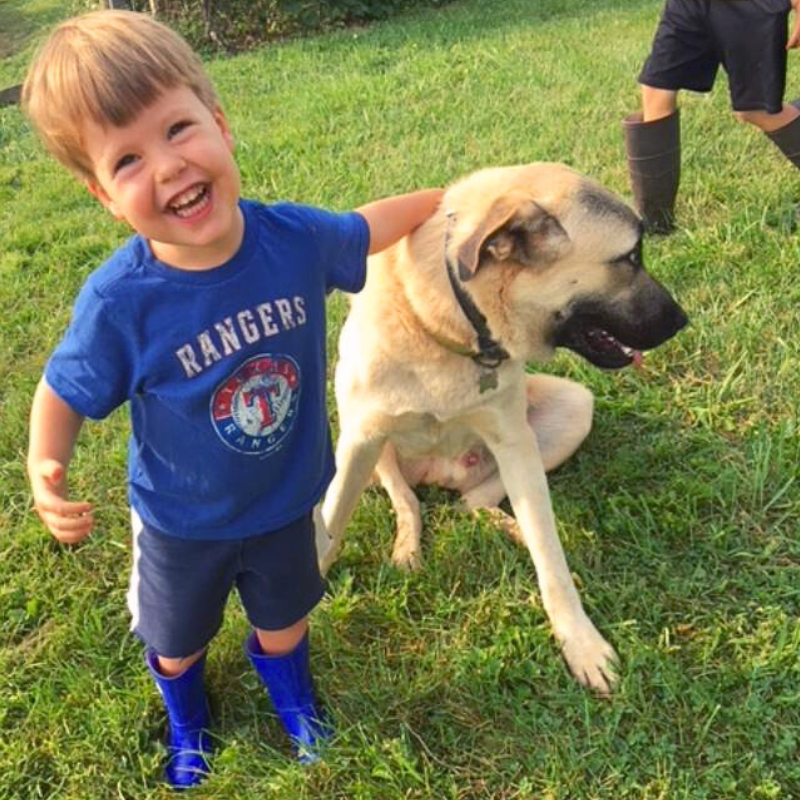
There was definitely a rough patch of about six months when we weren’t sure what we had gotten into and wondered if we’d made a huge mistake, but in the end we’re thrilled to have Mudge on our homestead. He has turned into an excellent livestock guardian dog, and we can’t imagine homesteading without him!
Do you have a livestock guardian dog? What are the challenges you’ve faced? What do you love about your dog?

Sign up NOW for my best tips delivered weekly to your inbox!
You’ll also get instant access to my library of free ebooks and resources.
You might also like...
14 responses to “The Best Livestock Guardian Dog for Chickens”
-
Lol, this made me laugh. We had an Anatolian and reading this brought back good memories…and reminded me of the ‘joys’ of having to wrestle with him a few times. He was 150 lbs of stubborn! But an amazing protector and gentle giant with the family.
-
They sure don’t seem very gentle at first, but I’m thankful we persevered because you’re right, he’s definitely a gentle giant now. 🙂
-
Hi there I found your post so helpful and comforting considering I spent yesterday crying over my Anatolian, 9 months old that I had to chase and wrestle with after he escaped. I can’t blame him because we haven’t yet found a good technique to train him. We have had a chicken casualty and he loves to chase them. Escape artist….yes. He’s too smart. Anyhow thanks for your words and advice. We will try the shock collar.
Nicole-
Oh yes, we’ve been there, Nicole! Hang in there!
-
-
-
Hi Kathleen! I really appreciate this article! We live in Mass & have had chickens, goats & sheep for quite sometime. The predators are rampant here. Including our yellow lab, we have the same problems that you faced with your chickens. So we used the shock collar and it seemed to work for her. Ive been looking into a guardian dog for some time. Im thinking of a Great Pyrenees, after reading this i may look into your breed. This article was especially helpful! Thank you again!
-
You’re so welcome, Donna! We can’t recommend a LGD highly enough…have fun picking out your breed! 🙂
-
-
Hi Kathleen!
I loved this post! I recued a great pyranese/blue heeler and she herds my brothers chickens into their pen and then just sits there and watches them…. For hours…. 🙂 Only problem is she won’t let them out to free range. Lol! My sister wants chickens so do you have any thoughts on how to teach her to let them out but still watch them?Thanks!
Gemma Petersen-
Hi Gemma, My husband is the animal guy / dog trainer around here, so I’ll check to see if he has any tips for you…stay tuned! 🙂
-
-
We have an invisible electric fence for our dogs. The dogs all wear collars and if they cross the boundary they get shocked. Warning beeps let them know they are close. Chickens are free.
-
I have a LGD that was already trained with farm animals. The problem is that he is so gentle, I highly doubt he would do anything if a predator was nearby. Any way to fix this?
-
So sorry to hear about some of the issues you’ve experienced with your LGD. I’ve had a variety of dogs (shepherd, bernese, mutts, etc. ranging in size from 24 to 125lbs.) For LGD’s, I’ve had 1 Pyr that I adopted as an adult and 1.5 yrs ago, I adopted 2 five-month old, male Karakachan pups.
When I first met them pups they and the rest of the litter where napping, scattered along the edges of a 20′ long x 6′ wide concrete patio. While I was talking to the breeder a mother duck and her 3 ducklings strolled down the center of the walkway. Pups would open their eyes / lift their heads…but went right back to sleep. WOW.
I’m not saying that the boys have been cake to train…they are SUPER smart and intuitive….always looking for a way to help / engage. The breeder invested a lot in them and since they are my first LGD pups I think it was actually better that I got them at an older age.
Originally had probs with collars, leashes, getting them into a car or truck…but with consistent, calm 10-min sessions every other day, we’ve solved that issue.
I had one bone possessive/
aggression issue about 3 months ago that I partially caused because I wasn’t paying attention. I didn’t know he had a bone and I was approaching with a playful attitude vs. calm, assertive…so when I reached over top of him, he reacted by hunkering down and growling. Since the boys weigh about 105lbs now, I immediately addressed that scenario (no shock collar). Retested twice and I haven’t had that problem surface again…but I always have a response ready for it.So far under my tutelage the key has been nose work to exercise their brains and one ~30-min walk a day. Rest of the time they have an acre to protect and play in.
Honestly the biggest challenge was building their ‘sound library’. Since the pups grew up waaay out in the country SO many sounds at my place were new to them. Being guardians, they didn’t know what they should alert me to and what they could avoid. Luckily the breeder had programmed a “thank you puppies” command that acted as a turn off switch…but there were plenty nights that I almost slept out on my hammock so I could address every trigger. Consistency paid off…although, I almost bought my neighbors sound cancelling headphones because the training period wasn’t fair to them and it took a few months : S I tried to think of it as…if I had a baby, they’d cry, and my sleep would be just as disturbed. These pups needed the time to learn and it’s my job to teach’m. Wasn’t fun…co-workers didn’t appreciate my sleep starved-self, but I’d do it again in a heart beat. Boys have clarity and I think it helped us bond.
Even with all of this and the more work I’ve invested…I REALLY like this breed and would recommend them for anyone who has 2 or more acres + a need for a livestock dog, aka a job for the pup. What I don’t recommend is getting 2 male pups at the same time.
-
Loved reading this! Very helpful. Our LGD’s are siblings (3/4 anatolians, with a little Pyrenees and maremma) and about a year old. I’m definitely in the stage of wondering if we’ve made a mistake and looking to rehome one of them! They are always better alone than together. I think getting siblings was a bad idea. Even being raised with chickens since they were puppies, one will still chase them and I suspect has been at fault for a few dead ones. We free range our 40 laying hens so it’s been a struggle. The sheep we got them for they are hardly ever with even though we always move them together and pen them up together at night. And you are definitely right about the wandering off. They go to visit our neighbor’s dog constantly and the farm is too large to make it 100% dog proof (about 35 acres of woven wire and board fence). We did try the shock collar and that worked really well for one and I just use the beep for her. The other one acts like she doesn’t feel it at all. Any suggestions?
-
Me and my wife had a black lab that we used a shock collar to train and had a terrible experience. Though we laugh when remembering. Not sure what went wrong but when we changed the battery’s in the controller it shocked our poor trooper continuously. The dog was doing back flips front flips all sorts of acrobatics. While I was desperately trying to take the battery out ( not funny at the time). Finally smashed the controller on the ground to get it to stop. Poor Trooper did not know what hit him. After we checked him and all was ok both me and my wife bursted out laughing it was the craziest sight we had ever seen. Needless to say we never used a shock collar on a dog again. But just writing this made me laugh and cry remembering that wonderful boy he was and how much I miss him.
-
Training with a shock collar means obedience through pain and fear, not respect and dedication. Shock collars are illegal in many countries and there is a reason for it. I understand that you were at a point where you didn’t know what else to do, but still, I think this is not the best way. It’s like hitting a dog to force obedience. Anyway, I truly wish you the best. I just don’t think to use a shock collar is good advice.



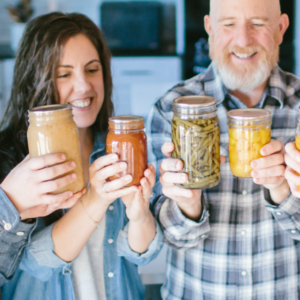

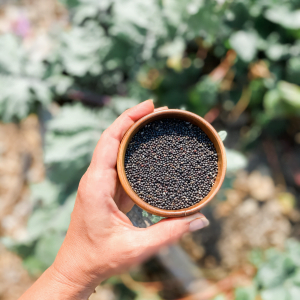
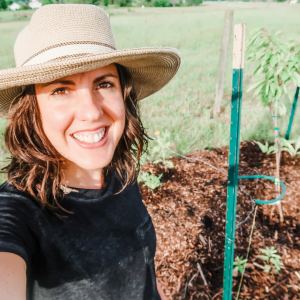
Leave a Comment